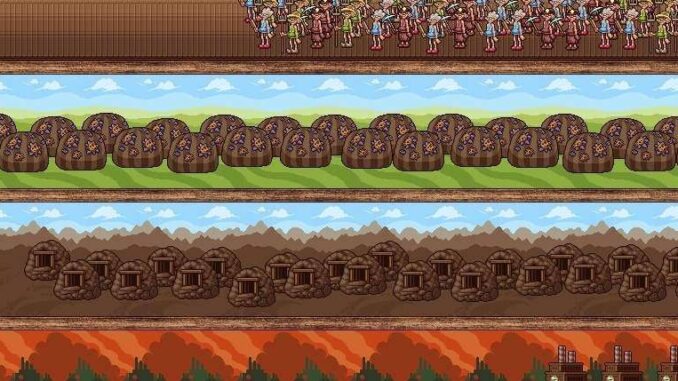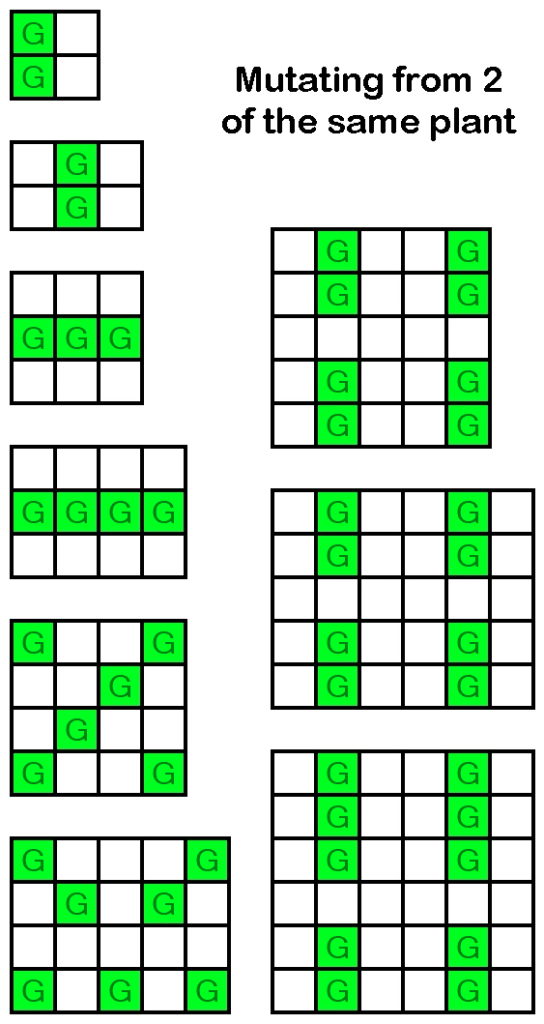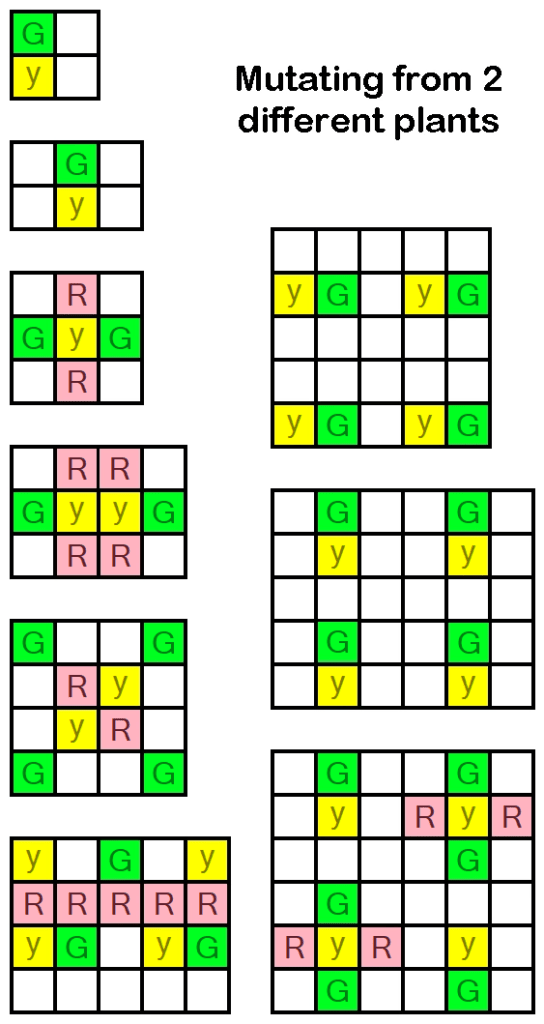Better Homes And Gardens Monster Cookies

Feeling lost when seeing your garden? Say no more! This guide will answer all your questions.
Introduction
In the Garden, plants and fungi can be grown and crossbred, obtaining new species as a result. Crops provide various benefits depending on the species, some granting passive buffs as they sit planted in the Garden, while others give rewards when harvested. The Garden can be unlocked by upgrading Farms to level 1 using a Sugar Lump.
Ascending will not reset the unlocked seed types, but it will clear the garden of any crops. The Garden has its own equivalent of ascension, which removes all planted crops and seeds except the starter seed of Baker's Wheat, in exchange for 10 sugar lumps.

Garden Size
The Garden's size starts out as a 2×2 grid, and can be expanded by further upgrading Farms with sugar lumps. The maximum size of 6×6 is unlocked at level 9.

As you can see, cost efficiency starts to drop slightly at garden levels 5 and 6 before rising sharply at levels 7 & above.
Growing Crops
Plants and fungi can be planted in the garden by clicking on the seed you would like to plant on the left-hand side and then clicking on an empty tile in the Garden. A seed can be easily planted more than once by shift-clicking to plant. At each tick, the game will check three things in order for each tile: age, contamination, and mutation. The length of one tick is determined by the type of soil which is currently in use, though a tick can be triggered instantly by spending a sugar lump.
Age
While growing, the crop ages every tick by its aging value, which in most cases is a randomized number. As the age increases, the crops will grow as bud, sprout, bloom and finally mature after reaching their mature age. The premature stages of growth increase as the crop reaches 1/3 and 2/3 of its mature age. A plant's passive effects will increase in potency with each growth stage, reaching full strength once the crop matures. For premature plants, any passive effects will only be at 10% for buds, 25% for sprouts, and 50% for blooms. A crop will decay once its age reaches 100 unless it is immortal.
Mutation
Initially, the Garden only has one seed available, that being Baker's Wheat. By leaving garden plots empty, Meddleweed may also appear. These two plants are the most fundamental species of the Garden: Baker's Wheat is the basis for regular plants, while Meddleweed is the basis of fungi. Most new species appear as a result of mutations (created by having two or more parent crops adjacent to an empty plot), but the two basic species of fungi (Crumbspore and Brown Mold) can be found as a result of manually harvesting Meddleweed (older = higher chance). When trying to unlock these 2 plants, DO NOT use the Harvest All tool, as it will harvest any newly spawned Crumbspore & Brown Mold along with everything else without adding their seeds to your collection. However, using Ctrl+Shift+Click is fine, since it only harvests mature instances of plants, rather than the entire garden.
If there is an empty plot, it has a chance to start growing a plant based on the adjacent (orthogonal and diagonal) plots. For example, if there are two adjacent Baker's Wheat, the empty plot may produce another Baker's Wheat or a random mutation: either a Thumbcorn or a Bakeberry. The exact probability can be calculated from random list mechanism. In general, the actual number is close, but not equal, to the base chance and can be approximately tripled. Most mutations require mature crops to trigger, but there are some exceptions. Additionally, certain mutations may also be prevented by having too many of a certain species adjacent to a slot (e.g. Ordinary Clover). See the species section below for a complete list of all mutation conditions.
Mutation set up

The first picture shows examples of optimal plant alignments for each Garden level when trying to mutate a new crop from 2 parents of the same species (example: Thumbcorn from 2 Baker's Wheats). Green squares (labeled with a "G") indicate planted crops. Empty squares indicate locations for potential mutations.

The second picture shows examples of optimal alignments for each Garden level for mutations from 2 different parents (example: Cronerice from Baker's Wheat and Thumbcorn). The green and yellow squares (labeled with a "G" and "Y" respectively) indicate the 2 types of planted tiles. The light red squares (labelled with an "R") indicate plots that could grow unwanted crops resulting from the mutation of 2 plants of the same type. For example, growing Baker's Wheat and Gildmillet may spawn unwanted Thumbcorns in the R plots.
Note that there are certain plants which require more than just 2 adjacent plants (Juicy Queenbeet, Shriekbulb & Everdaisy). If you're trying to grow one of these plants, DO NOT FOLLOW the mutation setups shown above (they won't work very well for you, if at all). For Juicy Queenbeets, plant 4 3×3 rings of Queenbeets in each corner. For Everdaisies, fill the 1st and 5th rows with Tidygrasses and the 3rd row with Elderworts. For Shriekbulbs, see this section for more details.
For the second chart, level 6 can be altered to remove its unwanted plots by using the setup for level 7 without the empty top row. However, this uses up one more space in the grid, meaning there is one less space for a new plant to grow. This is optimal if you are not actively managing your Garden to remove unneeded or unwanted plants.
Mutation tree

Contamination
Meddleweed, Crumbspore, and Doughshroom are able to contaminate other crops in an orthogonal direction when they are mature. The chance of this happening is very low. When it does occur, the contaminated plant is replaced by the attacking weed or fungus. Immortal plants are immune to contamination, as are certain other species. See the growth charts for an overview of contamination values and immunity information.
Strategy
Minimizing seed costs
As you progress further into the game and your CpS gets larger and larger, the cost of planting garden plants will rise in tandem, so trying to unlock some of the more elusive plants out there will often end up costing you an arm and a leg and then some. However, there are a couple of ways to make gardening much more affordable. Unlike the dollars ($) used in the Stock Market minigame, whose value is dependant on your raw (i.e. unaltered) CpS, the prices of Garden plants can and will fluctuate depending on which buffs & debuffs happen to be active at any given time. CpS-increasing effects (like Frenzies & Building Specials) will substantially increase the cost of planting seeds for the duration of the effect, so it is highly advised to not plant seeds during a Frenzy (or any CpS-increasing buff in general) until the buff wears off. On the other hand, things that lower your CpS will decrease seed costs accordingly, making them much more affordable.
The best way to minimize the cost of planting a seed is by clicking wrath cookies until you get a Cursed Finger debuff, which has the side effect of temporarily setting your CpS to 0. While the debuff is active, the price of planting seeds will drop to the absolute minimum, which is almost always much lower than the regular, CpS-based price. This makes them surprisingly useful when trying to grow hard-to-get plants like Duketaters, Shriekbulbs and the elusive Juicy Queenbeet. However, Cursed Fingers only have about a 1 in 40 chance of appearing, so Clots, despite being less effective at cutting costs, are still a viable alternative due to them appearing nearly 10 times as often as the leading competitor. To top it all off, wrinklers can also help a lot when it comes to lowering seed costs; having 10 of them at once will halve seed costs while also increasing overall cookie yield (see here for more details).
Unlocking Shriekbulbs
Shriekbulbs can be a bit tricky to unlock. Despite the fact that they can be unlocked in one of several ways, the odds of one appearing are pretty low. The conventional method for unlocking them is by using Duketaters, usually by filling the 1st, 3rd & 5th rows with them. However, duketaters are expensive to plant and only spend a very short amount of time mature. Alternately, you can use Elderworts. While planting Duketaters does have a higher chance of producing Shriekbulbs, Elderworts are cheaper to plant and are also immortal. They will never die & never need to be replanted ever, so this strategy is ideal for players who don't want to be replanting stuff 24/7. (As for the layout, you can use the same pattern as with Duketaters – fill every 2nd row with Elderwort and leave the in-between parts empty.)
Useful Plants
Whiskerbloom
If you tend to idle most of the time and rarely ever click Golden Cookies, you may want to fill the garden with whiskerblooms, as they will boost milk efficacy and thus increase the effects of the various kitten upgrades. Initially, you should plant them in regular or fertilizer soil to speed up the growing process (minimising your CpS to reduce planting costs), then switch to clay soil once they've matured. (The reduced tick speed is actually quite helpful in this case, as it lets the plants stay mature for longer before needing to be replanted.) With enough achievements & kitten upgrades, the whiskerblooms will result in a massive CpS increase. You can also add in nursetulips to boost the whiskerblooms' effects, but be aware that planting nursetulips will both reduce your overall CpS and also use up space that could otherwise be used for planting more whiskerblooms. The base increase in milk effects from the whiskerblooms (without nursetulips) can reach up to 7.2% once all the plants have matured (or 9% if using clay soil), which is nearly 50% more effective than Breath of Milk and only around 2.5% less efficient than a Diamond-slotted Mokalsium. Even better, since milk boosts (like CpS boosts) stack multiplicatively, using the whiskerblooms in combination with the aforementioned effects will lead to an even greater production boost!
Bakeberry
Bakeberry is one of the best plants in the game when it comes to getting lots of cookies really quickly. Filling up an entire field with bakeberries will give you a base CpS increase of 36% once they all mature. Harvesting all 36 bakeberries will yield a whopping 18 hours of CpS! (Note that the total yield is capped at 108% of your bank if using harvest all, so try to harvest them individually instead.) The cookie you get from the bakeberries are also affected by buffs & debuffs. Harvesting during a frenzy can give up to 3 hours and 30 minutes' worth of production for each bakeberry you harvest, so harvesting all 36 plants can yield over 5 days worth of production! However, planting the bakeberries in the first place costs quite a lot of cookies, so you should aim to plant them while minimizing your CpS (see this section for more details) in order to lower those upfront costs and further maximise your gain. Additionally, it's important to note that bakeberry harvesting rewards are capped at just 3% of your current cookies, so they should ideally only be harvested when you have loads of cookies saved up to get a bigger reward. (In order to get the full reward from all your bakeberries, you'd need to have at least 16 hours 40 minutes worth of CpS sitting there in your bank.) While duketaters could potentially be considered "better" than bakeberries (due to sporting a much greater cookie yield), duketaters are a lot more expensive, grow super slowly & do not provide a CpS bonus.
Golden Clover
Filling up an entire 6×6 field with Golden Clovers will grant a 108% increase in Golden Cookie frequency when all plants are mature (135% if using clay soil). This can lead to a Frenzy lasting for several minutes on end, because a new Frenzy cookie will likely appear before the existing Frenzy has ended, extending its duration over and over and over. The increased Golden Cookie frequency also increases the chance of getting combo effects, which can potentially yield massive amounts of cookies.
Nursetulip
Nursetulips are very effective at increasing the effectiveness of other plants. Since they reduce your CpS, Nursetulips should be used in situations where the goal isn't to boost your CpS. (Examples include Wrinklegills, Golden Clovers, Keenmoss, etc.) With a full 6×6 garden, the most effective way of using Nursetulips is to alternate between planting rows of Nursetulips and rows of the other plant. This will have a greater effect than simply planting 36 plants of the desired type, at the cost of slightly lowering your CpS.
You May Also Like
Better Homes And Gardens Monster Cookies
Source: https://re-actor.net/cookie-clicker-garden-guide/
Posted by: zanderspronful1972.blogspot.com


0 Response to "Better Homes And Gardens Monster Cookies"
Post a Comment